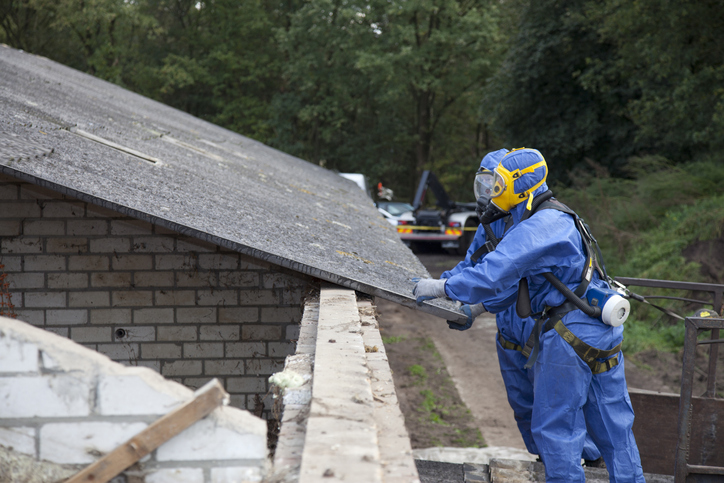Personal Protective Equipment (PPE) is vital to those who specialize in the maintenance or removal of toxins like asbestos. When asbestos resides in dilapidated or worn-down structures, workers or residents nearby can cause toxic dust to become airborne and easily inhaled or ingested. When you use the recommended, standard equipment during projects you help ensure the job gets done safely by reducing risks of harmful exposure.
Personal Protective Equipment (PPE) for Asbestos Abatement Workers
For most projects, disposable clothing is admissible, as long as it’s made of synthetic fabrics that don’t allow asbestos fibers to pass. This protective clothing should include coveralls, head and feet covers, gloves, and boots. To avoid attachment of asbestos fibers, clothes should have no external pockets or velcro, and gloves and shoes should be a thick textile material that can’t rip easily. Wear boots or reinforce shoes with plastic air-tight covers to keep the barbed fibers out. When the project is complete, make sure you throw out or adequately clean all coverall clothing before you go home.
Besides protective clothing, the most important piece of equipment in this list will be respiratory protection. Single-use, disposable paper dust masks are not recommended for asbestos removal. The Environmental Protection Agency (EPA) highly recommends:
- A half or full facepiece, negative pressure, air-purifying respirator with replaceable high-efficiency fillers
- A half or full facepiece, powered, air-purifying respirator (PAPR) with replaceable high-efficiency filters. This will need a battery-powered pump which will assist with breathing and provide positive pressure to the face area.
The Occupational Safety and Health Administration lists the standard requirements, definitions, and speculations for proper respiratory protection equipment.
Safety Tips and Resources for Handling Asbestos
If you’re an asbestos removal manager or worker, here are some helpful tips and resources to encourage proper handling and maintenance.
- Proper Training – While there are no current laws against a building or homeowner removing asbestos themselves, the EPA strongly advises against it. It’s important for everyone to have proper training when handling dangerous substances that can easily spread to the environment and harm others.
- Make Sure You’re Familiar with Safe Work Practices – It’s important to make sure you and your team are trained and know how to safely and efficiently complete any job involving airborne carcinogenic substances. Improperly performed abatement projects may even cause more harm than if the team would’ve never done anything. The EPA has a helpful list of practices for management and workers to enforce and follow.
- Test the Site – In order to make a proper estimate on the project and what it will take to complete, you’ll need to thoroughly test the allegedly contaminated site. For guidance in this area, ASTM D7521-22 outlines a standard test method for identifying asbestos in soil and estimating the concentration of asbestos in the sampled soil.
- Ventilate the Work Site If You Can – While not always possible, try to open windows, doors, and vents to reduce the concentration of poisonous asbestos dust.
- Use the Right Tools – When working asbestos removal operations, utilize specific tools and equipment. It’s imperative to use low-pressure equipment and avoid water sprays, jets, external power, or compressed air tools. Use of abrasive pads, brushes, saws, scrapers, drills, vacuums, and brooms should also be avoided when working in a worn-down structure contaminated with asbestos fibers.
Knowing and understanding these safety tips will help minimize potential injury to yourself, your team, and any innocent bystanders. This also helps you avoid any liability or legal issues if others get exposed to asbestos (or other work hazards) and develop an illness.
Contributing Author: Jennifer Verta
Jennifer Verta thrives as a digital content writer and SEO specialist at Mesothelioma Hub. She has been producing content for clients since before she graduated from the University of Colorado at Denver with a Bachelor of Arts in Communication and a Minor in English Writing. Jen’s mission is to help promote awareness of mesothelioma to as many people as possible by providing only the most up-to-date and accurate content available. When she isn’t cranking the gears at work, Jen can be found snowboarding, hiking, catching live music, or socializing with friends.
